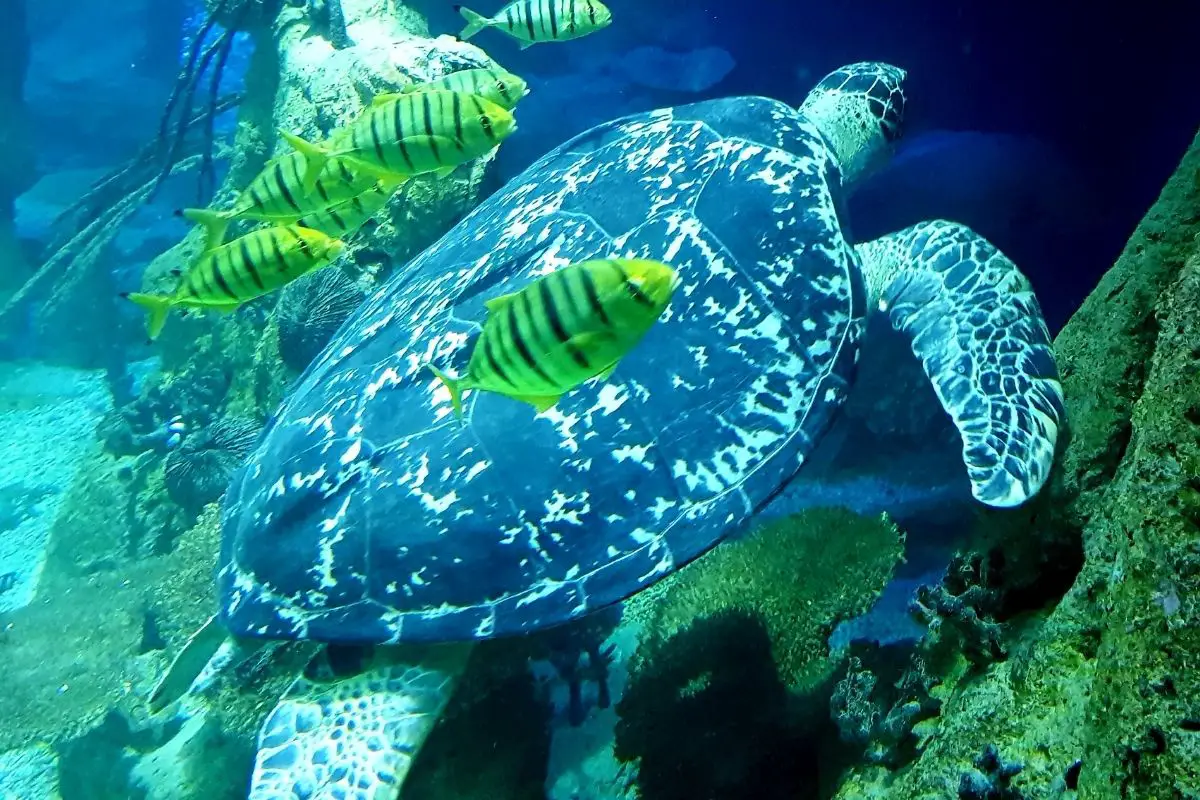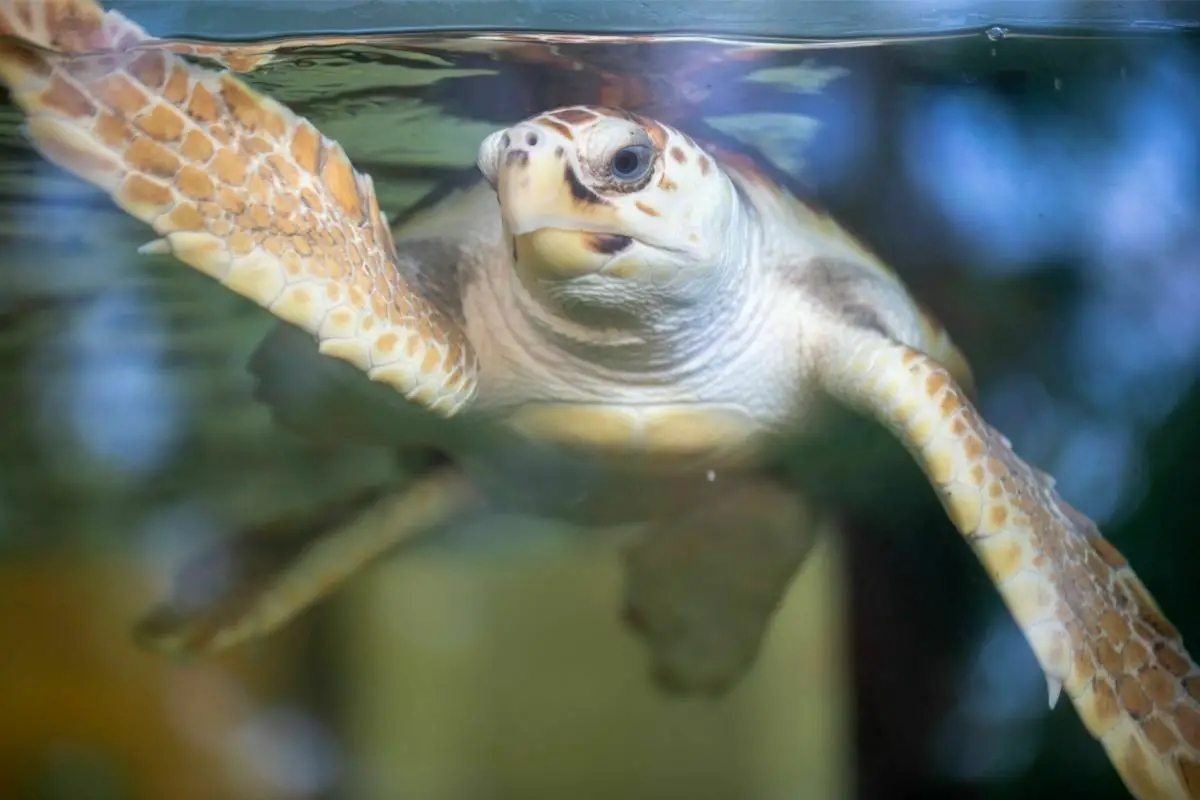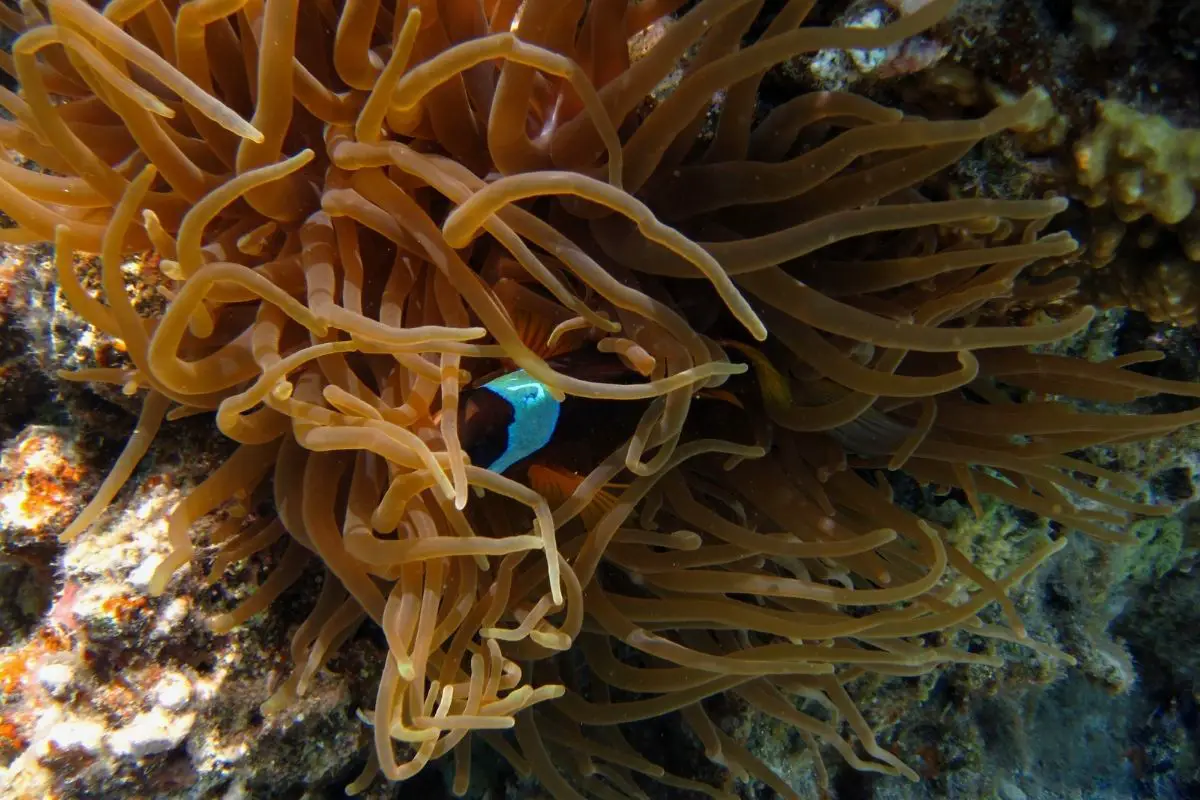If you are someone who wants to keep turtles, then naturally, you will want them to have the best home that you can possibly give them.
However, it is not a quick job to get your turtles’ home looking perfect – this is something that can take a lot of time and effort.

You might look at the finished product and feel as though something is missing.
You may even think that the ‘something’ that is missing from your turtles’ home is fish… Or is it?! Here, we are going to discuss whether or not it is a sensible idea to keep fish in the same tank as your turtles. So, read on to find out more.
The Quick Answer To Our Question
In summary, the short answer is of course – you are able to put fish and turtles in the same tank.
However, this is not something that is overly easy to accomplish – there are some set rules that you will need to bear in mind when you are homing your fish and turtles in the same tank.
There are a few things that you will need to make sure are in order, and sometimes a bit of luck will be involved in this process.
Ultimately, you want to take all the right precautions to ensure that you are able to keep your turtles and your fish happy in the same home.
Keeping turtles and fish in the same tank does require a lot of work, and it is for this very reason that you should think carefully as to whether or not this is a suitable decision for you.
Let’s Think About Turtle Species
Before we even contemplate the kinds of fish that turtles can cohabit with, we need to think about the species of turtles that can cohabit with each other.
Here’s the thing, it is quite tricky to get some turtles to behave in a tank together, let alone turtles amongst fish.
You need to be fully aware of the different behavioral patterns that different turtle species have towards each other.
For instance, it is important to mention that turtles that are from different species will usually attempt to impose violence upon each other.
Turtles can be notorious for attempting to fight or injure each other – and in the absolute worst case scenario, they might even try to kill each other.
That’s right, there are some species that you are not able to mix with others at all. For instance, snapping turtles are not allowed to be mixed with any other species of turtles – or you might have a messy scene on your hands.
It is important to note that a larger turtle that is of the very same species will happen to bully. injure, or even maim a much smaller turtle.
However, there are not just rules to bear in mind for turtles of different species. There are rules to bear in mind for male and female turtles and the number of each that you can have within a tank.
For example, if you have three or perhaps more turtles that are the same species, then you need to keep note of their gender.
If you are to have three turtles in a tank and one of them is female, and the other two are male, then the males will end up fighting.
Let’s Talk About Fish
Well, it is true that fish do make the matter of arranging the tank a lot more interesting… And, slightly more complicated. However, you can ensure that turtles and fish can live together in a tank in reasonable peace and harmony.
But, the first thing that you need to make sure that you have is a big enough tank for your turtles to live in – this is before you even think about adding fish into the mixture.
The typical rule that should be followed is that the tank should be filled with at least ten gallons of water, and this should be for every one inch of turtle shell per turtle.
If you own a particularly large turtle then you are going to need a lot of water. A lot of people will choose to own red-eared sliders, and these are turtles that can grow to be incredibly large in size.
The type of turtle that you are going to have, depends on the type of turtle tank that you are going to have.
However, if you are going to add fish to your turtle tank, then you are going to need a tank that has a lot of space that will allow your turtles and your fish to cohabit comfortably.
What Size Tank Do Fish And Turtles Need In Order To Live Comfortably?
So, if you are especially keen to include fish amongst your turtles, then you will need to consider investing in turtle tanks that are 60 gallons and above in size.
You will find that turtles and fish will be able to cohabit comfortably so long as they have enough space.
Here’s the thing, if your tank is too small then this gives turtles and fish less space which means more chance of fighting.
Too little space will allow your turtles and your fish to become highly aggressive and volatile – and this is not something that you are going to want for your fish and your turtles.
The perfect way to help avoid confrontations between your fish and your turtles is to get some fun tank ornaments, as these will ensure that your fish can hide from the turtles if they feel as though they must do so.
You can use small caves or even trees just to help your fish camouflage or blend in. We all need some space and privacy now and again, and fish are no different.
The Importance Of Having A Filter In Your Tank

It is really important that you fit your large tank with a filter, and one of the most recommended kinds of filters is canister-filtration systems.
This is due to the fact that the canister filtration systems hold the power to cope with the waste that comes from turtles.
It is not just waste that will come from the turtles – there will be bits of food that they have dropped, along with any other things that they have bitten off.
Canister filtration systems will work especially well in turtle tanks due to their multi-level filtration. These systems are a way of having the mechanical, the biological, and also the chemical filters that are able to really clean your tank.
The truth of the matter is that if you are going to have fish in your tank, then having a solid and strong filtration system will be absolutely necessary.
This is because in comparison to turtles, fish are not as tough or as strong. The kinds of conditions that turtles can endure differ pretty drastically from the conditions that fish can endure.
Making Sure That You Maintain Your Tank’s Conditions
You will not just need to consider the importance of having a filtration system in your turtle and fish tank. You will have to make sure that your tank as a whole is functioning properly.
You must ensure that you check, that you control, and that you fully maintain the pH levels of your tank. In fact, it is usually suggested that you consult and evaluate the pH levels of your tank monthly.
The pH level that you should be keen to stay at is between six and nine, and you will also need to ensure that your chlorine and ammonia levels are correct. Both of these levels should be at zero – or as close as they can be to zero.
You also need to make sure that you are able to aerate your water. Why? Well, doing this is highly important.
The main important outcome of doing this is pumping oxygen straight back into the water. Doing this is essential to keeping a perfect environment for bacteria to be able to thrive.
Will The Turtles End Up Eating The Fish?
Ultimately, this is one of the biggest concerns that comes with having turtles and fish sharing the same tank. You do not want your turtle and fish tank to transform into a scene that parallels the turtle-equivalent of ‘Jaws.’
Turtles are actually prone to consume fish as part of their diet. This is especially true for turtles who live in the wilderness, because, out in the big wide world, fish are a primary food source.
However, this would end up being especially hazardous in a tank environment – and would render all of our previous recommendations as untrue.
This is not the case. There are certain species of turtle that are more drawn to eating fish in comparison to others. The aquatic turtles are the kind that prefer to eat fish.
An example of the species of turtle that this applies to is the red eared slider. Alternatively, there are some species of turtle who do not eat fish all that often – and these include the box turtle.
Why Do Fish Require Hiding Places?

So, it is part of a fish’s nature to spend their time hurrying around the tank, and it is for this reason that they will be keen to find a hiding place.
However, having a fish who is frequently attempting to hide from a hungry turtle is not the best scenario… And, it would be unsurprising that the fish wouldn’t live for especially long.
This is something that you would expect to be fairly obvious, but regardless of whether or not turtles and fish cohabit the same space, fish quite enjoy hiding anyway.
You don’t have to make large investments in decorations for your tank – fish will not really appreciate the sum of money that you spend on hiding places in their tank.
Fish will appreciate any kind of hiding places that you can offer them. You could use things that you have easy access to – such as turned over flowering pots or pieces of driftwood and maybe even large rocks from your garden.
It is totally up to you whether or not you are keen to invest in more quirky aquarium accessories. If you are wanting to just use what you already have, then this is totally fine.
However, we do recommend that you inspect the aquarium accessories that you use as hiding places for your fish.
You need to make sure that your hiding places for your fish are especially safe and also secure for your fish.
We say this because the whole point of having hiding places for your fish is so that they are able to steer clear from the turtles when they feel they need to.
You don’t want the turtles to look at the hiding places as a challenge to get into – and you don’t want the turtles to end up finding this challenge tempting in any way.
The worst outcome would be the turtles eating the fish in their hiding places, which is far from ideal.
This is the reason why we do not solely suggest that you invest in water plants as hiding places for your turtles. Your fish will need much more substantial hiding places – water plants will not be much of a deterrent.
How Can You Find The Right Turtles For Your Tank?
You might now be wondering how exactly you can choose the correct turtle for your tank – this is something that is of course absolutely vital because this will have a huge impact on your fish being able to survive.
There are some species of turtles that are inclined to hunt down and consume fish more so than others.
As we mentioned before, the species of turtle that are the most inclined to attempt to eat fish are the red eared sliders, and the other species of turtles that are inclined to eat fish are the painted turtles, along with the cooters.
The species of turtles that are not so keen on hunting fish are the mud turtles and also the musk turtles.
These kinds of turtles are not as skilled as the slider turtles at hunting – and they actually do not appear to have the same keen interest in trying to hunt.
It is for this reason that there is much more leniency in terms of the kinds of fish that can be put in a tank amongst musk turtles.
The fish that are most comfortable living amongst musk turtles are tetras, or angel fish, along with zebrafish – and guppies are also comfortable living amongst musk turtles.
You do not want to introduce fish to a turtle species that is especially prone to eating fish. This would be especially unpleasant for you and also the fish.
What Can You Do If You Have A Slider Species And You Want Fish In Your Tank?
If you have one of these types of turtles, then you will be pleased to know that there will come a time where fish can comfortably cohabit your tank.
However, this should really be when the turtle has grown older and when it has matured in age.
This is because when sliders increase in age, then they will actually consume significantly less protein and they will instead want to eat many more vegetables.
When your turtle reaches this stage in their life, there is an especially slim chance that the turtles will want to eat fish. The fish will no longer be a target or a subject of interest to the turtles.
So, if you are the owner of a slider species of turtle, then you will be pleased to know that fish can actually live amongst them – but you will have to wait until they have matured in age.
You do not want the fish to be any kind of target for the turtle, and you do not want the turtle to become tempted in any way to try and have a nibble on it.
In Conclusion
Overall, there is a lot to think about when it comes to deciding on whether or not to put your fish and your turtles in the same tank.
It is especially clear that there are some strong guidelines that you need to take into account – and this is because some turtle species will actually target fish.
You do not want your fish to be constantly hiding from your turtles, and you do not want to one day glance over at your tank and see that your fish have disappeared.
If you own the seeker species of turtle, or another kind of species that prefers to eat fish, then you should wait until they mature and until they no longer crave the protein that fish would provide.
Then they will be able to live amongst fish. Or, if you are looking to invest in turtles then you should select a species that is not keen on consuming fish.
